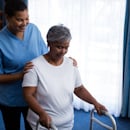
Population-Based Care: Plans for the Group or Individual
Does the term population-based care imply a cookie cutter approach to patient care instead of a plan sensitive to the needs of the individual? According to Peter Boland, population-based care “does not detract from individuality but rather adds another dimension, as individuals benefit from the guidelines developed for the populations to which they belong.” (Kelley, 2012).
Defined by the American Medical Association as an approach “that allows one to assess the health status and health needs of a target population, implement and evaluate interventions that are designed to improve the health of that population, and efficiently and effectively provide care for members of that population in a way that is consistent with the community’s cultural, policy and health resource values.” (Kelley, 2012). This practice is one of managed care’s fundamental premises.
In the past, healthcare providers treated patients on a case-by-case basis, with little knowledge of what care decisions may have the greatest impact on the patient. This practice was due to the lack of national databases that can aggregate and normalize data across all care settings for all patients. Access to and analysis of this data allows practitioners to cohort patients based on their individual needs and the likelihood of future adverse events (Rowe, 2017).
Today, with the growing interoperable systems which aggregate data from multiple clinical systems, we can help ensure that the data collected and disseminated has all the information required to monitor and manage population health and provides quality metrics (Rowe, 2017). This aggregate data may be viewed as a collection of health outcomes of any given group of individuals. These outcomes may vary among the various groups within a population as well as among populations. The reasons for the variation are varied but include age, socioeconomic status, healthcare availability, race, culture, and even zip codes (Rosario, 2017).
Why is Population-based Healthcare Important?
- It focuses on the health and well-being of particular groups of people
- Provides improved access to care
- Better patient engagement through empowerment to manage their care
- Decreased cost
(Rosario, 2017)
Nursing and Population-Based Care
The National Advisory Council on Nurse Education and Practice published five recommendations that emphasize the alignment of nursing education and practice with new and emerging models of healthcare. These recommendations underscore the need for Title VIII funding to advance nursing education by providing support for educational institutions and partners to devise new models of care to move the nation’s populace toward better health (National Advisory Council on Nurse Education and Practice, 2016).
It is unclear how population-based care will affect the future of bedside practice. One thing is clear, the health of our communities and populations directly impacts the work of the bedside clinician. Nursing has always practiced population-based care, in that we all are experts in one of the populations (geriatrics, older adults, young adults, adolescents, school age, toddlers, and infants). It is time for us to expand our care from individual signs and symptoms to care that encompasses the health and well-being of our communities.
References
Colduvell, K. (2016). The Pros to a second degree nursing programs.
EveryNurse.org. (2013). Is the nursing profession right for you? Nurses speak out on qualities one should have to enter the nursing profession.
NursingLicensure.org (2018). Becoming a nurse with a bachelor’s in another discipline: your second degree nursing options.




